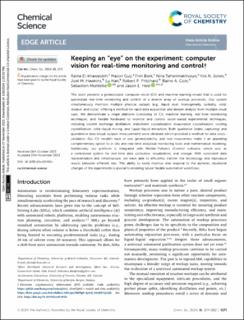Keeping an “eye” on the experiment: computer vision for real-time monitoring and control
| dc.contributor.author | El-Khawaldeh, Rama | |
| dc.contributor.author | Guy, Mason | |
| dc.contributor.author | Bork, Finn | |
| dc.contributor.author | Taherimakhsousi, Nina | |
| dc.contributor.author | Jones, Kris N. | |
| dc.contributor.author | Hawkins, Joel M. | |
| dc.contributor.author | Han, Lu | |
| dc.contributor.author | Pritchard, Robert P. | |
| dc.contributor.author | Cole, Blaine A. | |
| dc.contributor.author | Monfette, Sebastien | |
| dc.contributor.author | Hein, Jason Ellis | |
| dc.date.accessioned | 2024-03-26T14:01:29Z | |
| dc.date.available | 2024-03-26T14:01:29Z | |
| dc.date.created | 2024-01-12T10:20:52Z | |
| dc.date.issued | 2024 | |
| dc.identifier.issn | 2041-6520 | |
| dc.identifier.uri | https://hdl.handle.net/11250/3124269 | |
| dc.description.abstract | This work presents a generalizable computer vision (CV) and machine learning model that is used for automated real-time monitoring and control of a diverse array of workup processes. Our system simultaneously monitors multiple physical outputs (e.g., liquid level, homogeneity, turbidity, solid, residue, and color), offering a method for rapid data acquisition and deeper analysis from multiple visual cues. We demonstrate a single platform (consisting of CV, machine learning, real-time monitoring techniques, and flexible hardware) to monitor and control vision-based experimental techniques, including solvent exchange distillation, antisolvent crystallization, evaporative crystallization, cooling crystallization, solid–liquid mixing, and liquid–liquid extraction. Both qualitative (video capturing) and quantitative data (visual outputs measurement) were obtained which provided a method for data cross-validation. Our CV model's ease of use, generalizability, and non-invasiveness make it an appealing complementary option to in situ and real-time analytical monitoring tools and mathematical modeling. Additionally, our platform is integrated with Mettler-Toledo's iControl software, which acts as a centralized system for real-time data collection, visualization, and storage. With consistent data representation and infrastructure, we were able to efficiently transfer the technology and reproduce results between different labs. This ability to easily monitor and respond to the dynamic situational changes of the experiments is pivotal to enabling future flexible automation workflows. | en_US |
| dc.language.iso | eng | en_US |
| dc.publisher | Royal Society of Chemistry | en_US |
| dc.rights | Navngivelse-Ikkekommersiell 4.0 Internasjonal | * |
| dc.rights.uri | http://creativecommons.org/licenses/by-nc/4.0/deed.no | * |
| dc.title | Keeping an “eye” on the experiment: computer vision for real-time monitoring and control | en_US |
| dc.type | Journal article | en_US |
| dc.type | Peer reviewed | en_US |
| dc.description.version | publishedVersion | en_US |
| dc.rights.holder | Copyright 2024 The Author(s) | en_US |
| cristin.ispublished | true | |
| cristin.fulltext | postprint | |
| cristin.qualitycode | 2 | |
| dc.identifier.doi | 10.1039/d3sc05491h | |
| dc.identifier.cristin | 2225134 | |
| dc.source.journal | Chemical Science | en_US |
| dc.source.pagenumber | 1271-1282 | en_US |
| dc.identifier.citation | Chemical Science. 2024, 15, 1271-1282. | en_US |
| dc.source.volume | 15 | en_US |
Tilhørende fil(er)
Denne innførselen finnes i følgende samling(er)
-
Department of Chemistry [433]
-
Registrations from Cristin [9676]

